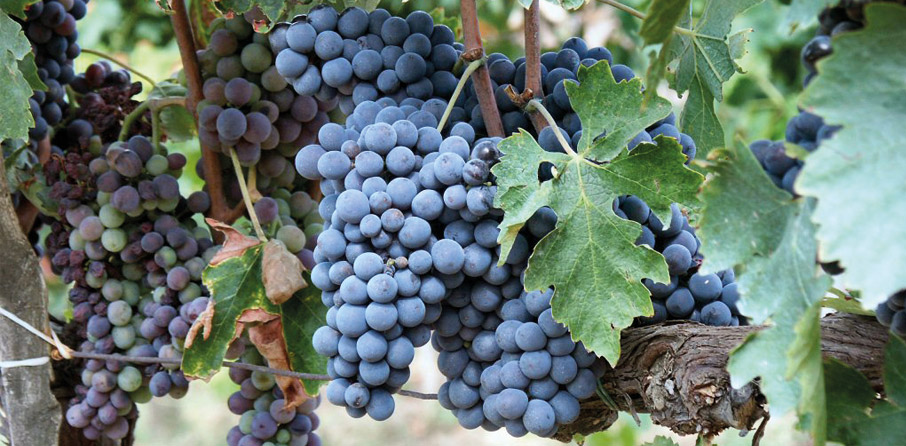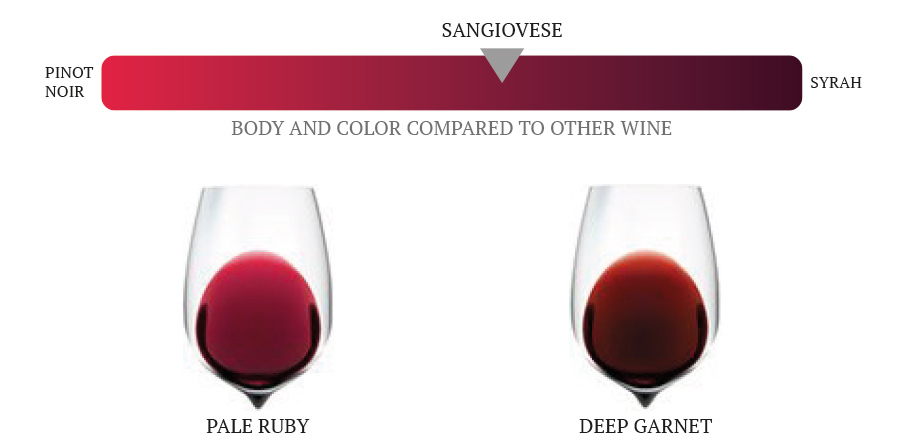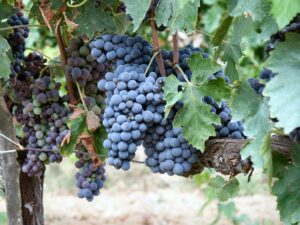Sangiovese is a grape with ancient origins. Primarily grown in central Italy, it’s widely recognized today as the pride of Tuscany. It is used to produce some of the most desirable red wines of the world, and it is the main grape for Chianti Classico wines.
It is a remarkably adaptable grape and is known for taking on the properties of the areas in which it is grown. For that reason, it’s pretty difficult to nail down a single overarching taste profile for this vine.
Let’s try to better understand the characteristics of the Sangiovese grape
Sangiovese is a dark grape varietal known for high yields, slow ripening and being notoriously difficult to work with. It loves arid clayey-siliceous-calcareous soils. This grape has compact, conical, medium-sized clusters and vigorous, disease-resistant shoots.
The berries are elongated and swollen, purplish-black in color, with a light and consistent skin and a slightly fleshy and acidulous pulp.
The tasting of Sangiovese in 3 phases:
1) VISUAL EXAMINATION
The wine obtained from Sangiovese grapes vinified as a single-variety wine has an intense ruby red color, with good transparency and reflections ranging from violet to garnet depending on how it has been aged.
The structure is generally good, and it is possible to obtain wines of great body, in particular in case of Riserva and Gran Selezione, for which the best grapes are used.
2) OLFACTORY EXAMINATION
Sangiovese opens on the nose with fruity notes, of red and black berried fruits as well as strong floral notes of violet. Among the fruits, we mainly recognize: black cherry, raspberry, plum, blueberry and blackberry.
The aging in wood gives Sangiovese spicy aromas of vanilla, licorice, cinnamon, nutmeg and black pepper, as well as balsamic notes of menthol and eucalyptus.
When aged for a long time, wines acquire tertiary aromas of tobacco, leather, cocoa and chocolate.
3) GUSTATORY EXAMINATION
On the palate, Sangiovese has a strong acidity and an appreciable content of tannins.
From these characteristics derives its predisposition to the aging in wood, which allows to soften the more “rustic” notes and at the same time improves the structure.
Wines have a moderate alcohol by volume which gives warmth and smoothness.
The persistence is generally very good, with flavors of red fruit such as black cherry, plum and blueberry.
Pairing Sangiovese with food
The savory and tasty notes of Sangiovese make it an ideal wine for food pairings as it will easily complement a wide range of dishes. Tomato-based dishes are an obvious choice considering the wine’s origin. The wine also pairs well with roasted meats and is a great accompaniment to a Sunday roast.
Sangiovese is a perfect wine to sip alongside some rustic roasted veggies or a hearty vegetable or bean-based soup.
The aromatic and gustatory profile of Chianti Classico and Chianti Classico Riserva
As it is known, Chianti Classico DOCG wines, according to production disciplinary, must be produced with Sangiovese grape in percentages ranging from 80 to 100%.
Therefore the aromatic profile of Chianti Classico is strongly characterized by the aromatic qualities of its main protagonist: Sangiovese grape.
Despite in Chianti Classico are frequently used other grapes – such as Cabernet Sauvignon and Merlot – will be the qualities of Sangiovese to be noticed from the glass, to which will follow the qualities of other grapes and the complex aromas given by the aging in wood and time.
Chianti Classico DOCG wine is characterized by an intense and brilliant ruby red color, with a moderate transparency, in some cases even rather low ; the taste is dry and sapid.
Among the most common aromas that can be found in Chianti Classico we have
black cherry, plum, blueberry and blackberry, whereas in floral aromas it is violet to play the main role.
Chianti Classico Riserva DOCG, which requires an aging of at least 24 months, is a more “noble” wine; it has more finesse, a longer bouquet and a cleaner and velvety taste.
Dark red tending to garnet, it has a scent of spices and berries and an important structure.
Thanks to the aging in wood, in Chianti Classico Riserva will also be perceived spicy aromas such as vanilla, licorice, cinnamon and black pepper, as well as balsamic hints of menthol and eucalyptus. Other typical aromas include tobacco, leather and chocolate.
Thanks to the aging in wood, in Chianti Classico Riserva will also be perceived spicy aromas such as vanilla, licorice, cinnamon and black pepper, as well as balsamic hints of menthol and eucalyptus. Other typical aromas include tobacco, leather and chocolate.
| What are the characteristics of the Sangiovese grape? | How to describe Sangiovese? | |
 |
 |
|
|
|
|
| Which are main flavors and aromas of Sangiovese wines? | ||
| Fruit: plum, red currant, red cherry, fresh raspberry, fig Herbal/Vegetal: herbs, violets, basil, pepper, sun-dried tomato Other: leather, licorice, clay, coffee, tobacco, cinnamon, balsamic |
||
| Which food should be paired with Sangiovese wines? | Why we like the Sangiovese varietal, grape and wines? | |
|
|
|
